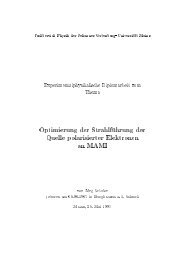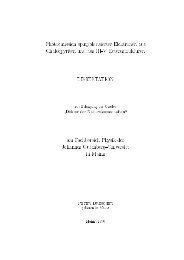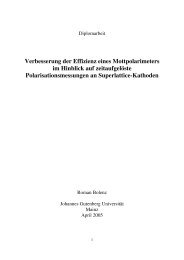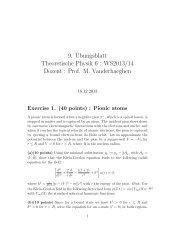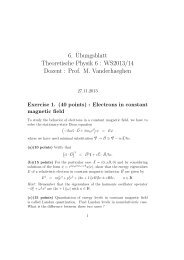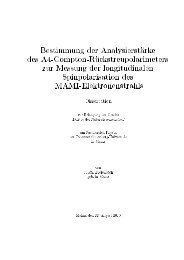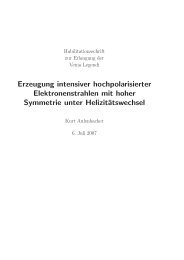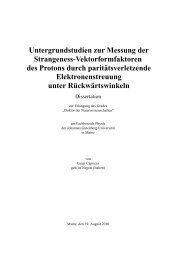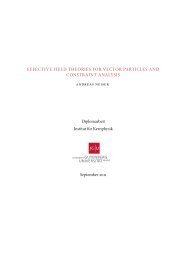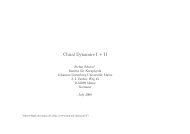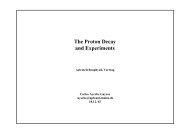Aufbau einer gepulsten Quelle polarisierter Elektronen - Institut für ...
Aufbau einer gepulsten Quelle polarisierter Elektronen - Institut für ...
Aufbau einer gepulsten Quelle polarisierter Elektronen - Institut für ...
Erfolgreiche ePaper selbst erstellen
Machen Sie aus Ihren PDF Publikationen ein blätterbares Flipbook mit unserer einzigartigen Google optimierten e-Paper Software.
18 P. Hartmann et al. / Nucl. Instr. and Meth. in Phys. Res. A 379 (1996) 15 – 20<br />
zation is reversed once per second by switching the<br />
circular polarization of the laser light. This results in<br />
four detector counting rates N ; L N; R N+ L and N+ R . The<br />
asymmetry<br />
A = 1 ;p Q<br />
1+ p Q<br />
with<br />
Q = N+ L N; R<br />
N + R N; L<br />
(2.4)<br />
is then to first order independent of detector asymmetries<br />
and beam intensity fluctuations. The measured<br />
asymmetries are corrected for false asymmetries from<br />
the Pioloform carrier and for inelastic background according<br />
to Fletcher et al. [24].<br />
Residual systematic errors like differences of the beam<br />
polarization for + and – are taken into account.<br />
The total systematic error is estimated to be 4.6 %.<br />
In addition to the gold foils, a phosphorescent screen<br />
and a tungsten wire are mounted on the target holder.<br />
With the tungsten wire the energy spread of the electron<br />
beam can be determined by scanning the beam<br />
spot size in the dispersive plane of the spectrometer.<br />
The subsequent Faradaycup is used to measure the<br />
transmitted beam current.<br />
3. Results<br />
Fig. 5 shows measurements with the apparatus in phase<br />
mode (a) and in spectrometer mode (b). In phase<br />
mode the deflector resonator (phase analyzer) is switched<br />
on to measure the phase-dependent properties of<br />
the electron bunch. In spectrometer mode non-phasedependent<br />
properties of the electron beam are measured<br />
and the deflectorresonator is off. All data were<br />
taken at a laser wavelength of 836 1 nm.<br />
Fig. 5 (a) shows as an example an electron bunch generated<br />
with an accelerating voltage of 100 kV at a<br />
quantum efficiency of 510 ;4 . The transmitted current,<br />
measured with the Faradaycup, is plotted vs. the<br />
phase (time) of the phase analyzer. The shown bunch<br />
is charged with 0.65 fC.<br />
The widths of the electron bunches (FWHM) for different<br />
bunch charges are shown in Fig. 6 (a). We observe<br />
a strong dependence of the bunch length on the<br />
bunch charge. This is considered to be an external<br />
space charge effect. It takes place during the transport<br />
of the bunch from the photocathode to the deflector<br />
cavity [25,26]. Fig. 5 (b) shows the integral energy<br />
spread of the beam measured in spectrometer mode.<br />
The current on the Mottdetector tungsten wire is plotted<br />
vs. wire position. On the top axis of the plot the<br />
calibrated energy scale is applied. Each of the curves<br />
corresponds to a different bunch charge. The base<br />
widths of the curves are plotted in Fig. 6 (b). The monotonous<br />
increase of the energy spread with the bunch<br />
charge indicates that the major amount of the space<br />
charge potential is transformed into kinetic energy. In<br />
a simple electrostatic model the offset in kinetic energy<br />
of the outermost particles of the bunch relative to<br />
the center particle is proportional to their initial space<br />
charge potential, which itself is proportional to the total<br />
number of electrons in the bunch. The average polarization<br />
of the electron beam vs. the bunch charge<br />
is plotted in Fig. 6 (c). No dependence on the bunch<br />
charge was seen up to 8 fC. The highest charge investigated<br />
would correspond to a mean beam current of<br />
20 µA if a pulse repetition rate of 2.45 GHz (MAMIrf)<br />
could be achieved. The rightmost two points have<br />
an<br />
(a)<br />
Time/ps<br />
-20 -10 0 10 20 30 40<br />
100<br />
(b)<br />
9<br />
Energy spread / eV<br />
-200 -100 0 100 200<br />
90<br />
8<br />
Current in Faradaycup / pA<br />
80<br />
70<br />
60<br />
50<br />
40<br />
30<br />
20<br />
Signal / a.u.<br />
7<br />
6<br />
5<br />
4<br />
3<br />
2<br />
1<br />
10<br />
0<br />
0<br />
-20 -10 0 10 20 30 40<br />
-1<br />
48.0 48.5 49.0 49.5 50.0 50.5 51.0 51.5 52.0<br />
Phase / degree<br />
Wire position / mm<br />
Fig. 5. (a) An electron bunch generated with an accelerating voltage of 100 kV at a quantum efficiency of 510 ;4 . To guide the eye, the<br />
points are connected with straight lines. (b) The energy distribution of the pulsed electron beam, measured in spectrometer mode (see text).<br />
Each of the curves corresponds to a different beam current.



